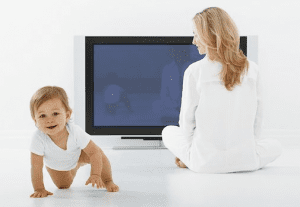
At Lose Baby Weight, we are big advocates of getting you and your family to be as active as possible and getting into the habit of being active and playing and moving more is one of the best things you can do for you, your family and all of your health. But if you do find your children wanting to watch TV is is bad for them? And what are the best choices to make? Our Lose Baby Weight researcher has looked at the facts for us:
Scientific evidence
One of the main concerns regarding small children and television viewing is linked to the rising obesity epidemic. More than 1 in 5 Australian children are considered overweight or obese, and the research links this strongly with that fact that children are sitting at home watching television rather than running around the garden or playing in the park.
There are also studies which link watching a large amount of television with a lack of concentration and focus in small children, and it can also delay the development of speech and language. Much of the research in this field is contradictory however, and more studies need to be completed before we can know exactly what effect watching hours of television will have on children in the future.
Contradictory Evidence
As this field of research is still relatively new, there is a huge amount of debate still going on about whether television is as damaging as previously thought. The most recent research agreed that children who watched television on their own did have poorer vocabulary than those who did not, but also found that children who watched television with their parents actually had a better vocabulary.
One hour per day
In 2009, experts evaluated the research so far and made the recommendation that Australian children under the age of 5 should be watching no more than one hour of television per day. The guidelines were initially developed for use in nurseries and kindergartens, but should also be applied to parents who care for their children at home.
It is often hard to keep to these guidelines for small children, especially if they have older siblings who like watching television before and after school.
Quality over quantity
It’s therefore generally accepted that allowing a small child to watch television for extended periods of time isn’t a great idea. However, the evidence seems to show that if a child and a parent watch television together then the effect is more positive.
Limiting television to one or two hours per day means that the parent needs to exercise more control over what sorts of programmes their child is watching. There is a massive choice of programming dedicated to pre-school children, some of which is educational, interesting and stimulating. On the other hand, there is a lot of programming which is probably worth avoiding. Understanding what sorts of programmes provide a positive benefit to a child can help decide what they should be watching.
What to avoid
It is best to avoid programs which feature loud music, scary images or scenes which your child might struggle to understand. Small children are often scared by action based cartoons, which are very popular with older children. If in doubt, parents should watch the shows first to see whether they are appropriate for their children.
What to watch
Very small children are entranced by In The Night Garden, which is gentle and calming, and features lovable creatures all living in a fantasy garden. Hi-5 is one of the most popular Aussie TV exports and the emphasis on singing and dancing will get children up off the sofa and dancing around the room.
Similarly, the Wiggles show has an emphasis on movement and singing, and small children love singing along with their favourite characters. Other shows which are of consistently high quality and are popular with children and parents include Play School, Lazytown and Teletubbies. As well as watching TV shows live, there are numerous DVDs available so that parents can control what their child watches as well as when they watch it.
Building on the viewing experience
Research has proven that children get more out of television when watching with a parent. Parents can speak to their children about what they are seeing, and ask questions about what the characters are doing or saying.
Children love singing along with parents and the characters on television, and repetition of words and songs will help vocabulary also. Another way to build on what has been seen on television is to base play or craft activities around what the child has seen, for example making a model or painting a picture of a character, trying to dress up like one of their favourite television stars or making a superhero outfit just like Sportacus from Lazytown.
